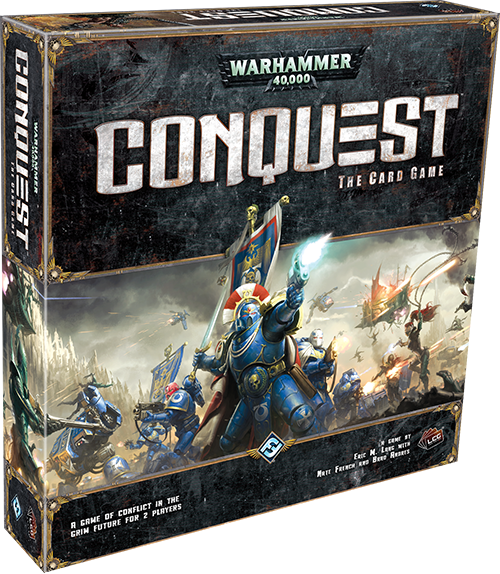
Orbital Strike Team Incoming
Preview Deployment and Planets in Warhammer 40,000: Conquest

The fires of war burn brightly from star to star. Everywhere the fortresses of Man are steeped in blood and ancient enemies appear from the darkness. Sensing weakness they gather for the kill.
Fantasy Flight Games recently announced Warhammer 40,000: Conquest, a new Living Card Game® of galactic warfare in the Traxis sector of the Ultima Segmentum. In the game, you take command of a warlord leading one of seven factions to glorious victory, claiming planets in your name and establishing dominion over that region of space. If your warriors and tactics prove superior to your opponent, you will emerge victorious, but if your armies are overwhelmed, you will surely be forgotten.
In today’s preview, we’ll take a closer look at how your armies come into contact with your opponent by examining both planet cards and the deployment phase.
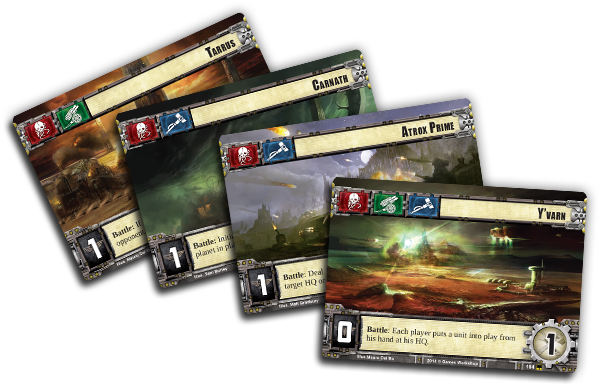
Innumerable Worlds
At the center of any game of Warhammer 40,000: Conquest are the planets of the Traxis sector, represented on planet cards arranged in a row between the players. Out of ten planet cards, seven are dealt facedown in a line between you and your opponent at the beginning of the game. Because three planet cards are left unused in each game, and because the planets are arranged randomly, every game of Warhammer 40,000: Conquest will feature different planets in an unique order. If you win initiative for the beginning of the game, you begin by revealing five planet cards, leaving your two rightmost planets facedown. These planets will be revealed as the game progresses.
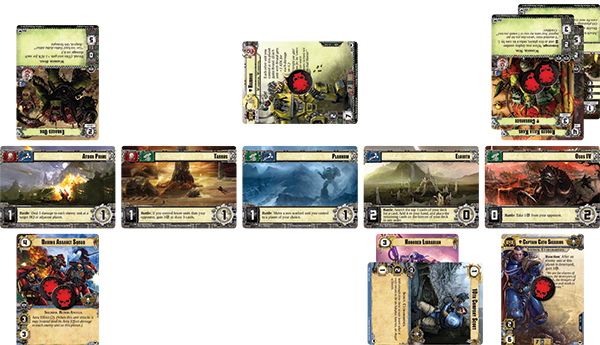
The planets that lie before you hold the key to victory over your opponent. In the upper left-hand corner of every planet card, you’ll find one or more type symbols. These symbols represent the strategic importance of the planet. Some planets possess valuable materials needed by armies in the 41st millennium. These planets show the red Material type symbol. Other planets are important to the war effort, and bear the green Strongpoint symbol. Still other planets hold powerful or ancient technology, designated with the blue Tech symbol. These symbols have no powers inherently, but if you can seize three planets that share a common symbol before your opponent, you win the game! Every planet possesses at least one of these symbols, but some planets, like Atrox Prime, possess two, and Iridial has all three type symbols.
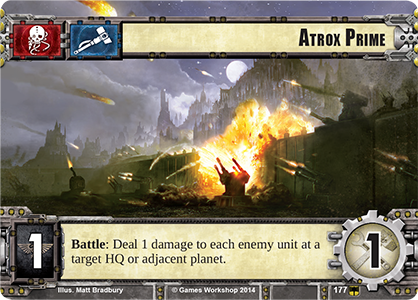
Begin Deployment Immediately
Planets are the locations where you deploy your army units during the deployment phase. The deployment phase takes place at the beginning of each round, representing the gathering and deploying of armed forces that precedes military engagement. At the beginning of the deployment phase, the player with initiative deploys one card from his hand. Army units are immediately deployed to one of the face-up planets arranged between the players. Support cards remain in play at your headquarters, whereas attachment cards are attached to another card or game element.
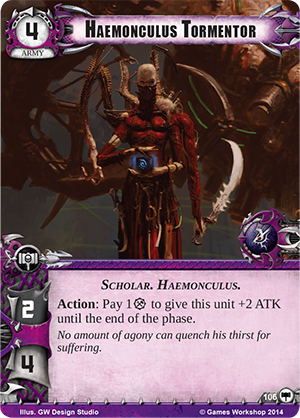 On your turn, you may deploy one card by paying its resource cost, shown in the upper left-hand corner of the card. For example, if you want to deploy the Haemonculus Tormentor (Core Set, 106), you begin by paying the four resources that this army unit costs. You must determine which planet this unit will deploy at. After you deploy, your opponent has the chance to deploy a card, before the chance to deploy passes back to you. Because the opportunity to deploy passes back and forth between the players, the order in which you deploy your units becomes a vital concern. By waiting to play some units, you gain a greater picture of what your opponent is most likely to accomplish this round. With this extra information, you can play your high-impact units where they can benefit you the most.
On your turn, you may deploy one card by paying its resource cost, shown in the upper left-hand corner of the card. For example, if you want to deploy the Haemonculus Tormentor (Core Set, 106), you begin by paying the four resources that this army unit costs. You must determine which planet this unit will deploy at. After you deploy, your opponent has the chance to deploy a card, before the chance to deploy passes back to you. Because the opportunity to deploy passes back and forth between the players, the order in which you deploy your units becomes a vital concern. By waiting to play some units, you gain a greater picture of what your opponent is most likely to accomplish this round. With this extra information, you can play your high-impact units where they can benefit you the most.
For example, you most likely want to deploy support cards before you play units. Playing support cards gives your opponent little information about your plans for the round, forcing your opponent to make choices about where to deploy his unit without seeing where your first unit will go. Knowledge of which planets your opponent’s units deploy to gives you some insight into whether you can win command struggles or battles at a given planet.
Which planet you deploy your units to is a critical consideration in Warhammer 40,000: Conquest as well. Your units can be deployed to any face-up planet, but only the first planet can be claimed by a player each round. It may be tempting to concentrate wholly on the first planet each round, but spreading your forces across planets is crucial to maintaining your warlord’s offensive. Planets other than the first planet cannot be claimed each round, but they can grant you resources and added card draw during the command struggle, as will be described in a future preview. The necessity to gather extra resources and cards must be balanced against the battles that must be fought this round. Combat will also be described more fully in a future preview.
Once a player neither deploys or takes an Action, he passes, forgoing the opportunity to deploy more cards or take more Actions this phase. The deployment phase ends once both players have passed, and the command struggle begins at planets throughout the Traxis sector, as we’ll describe in our next preview.
Fully Deployed
Your armies may be deployed across the planets of the Traxis sector, and combat will soon begin. Only through victory and glory can your warlord escape the ignominy of being forgotten. Prepare your soul for battle, and check back for more previews of the intense galactic warfare of Warhammer 40,000: Conquest!
…
